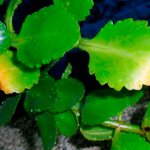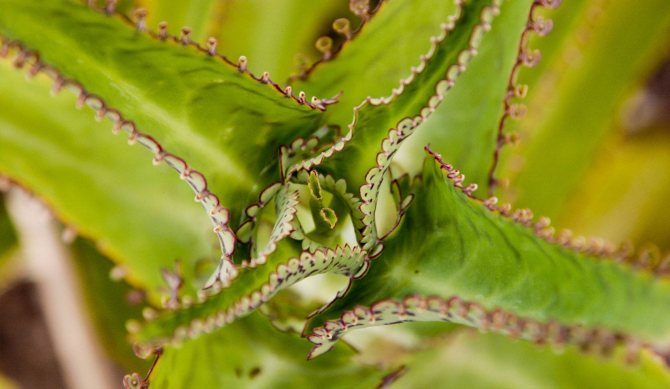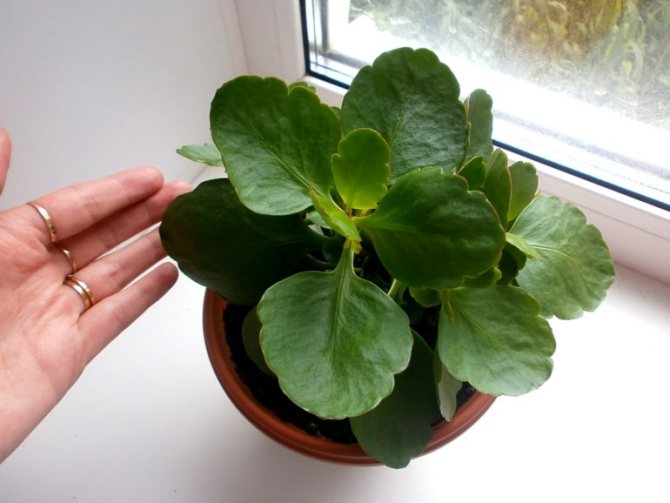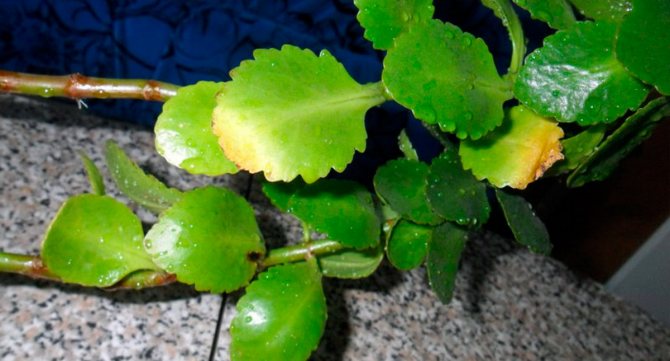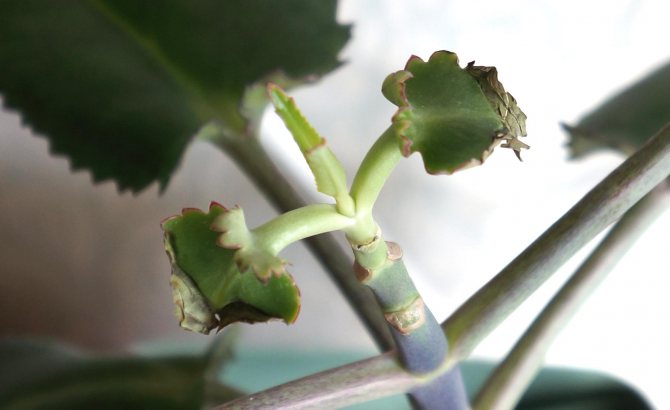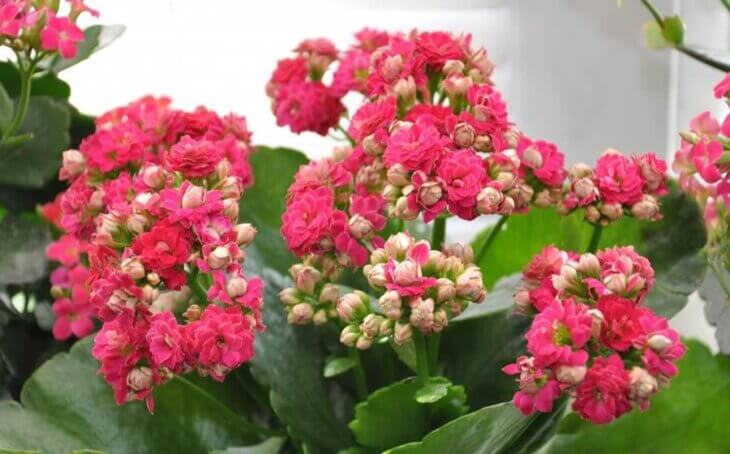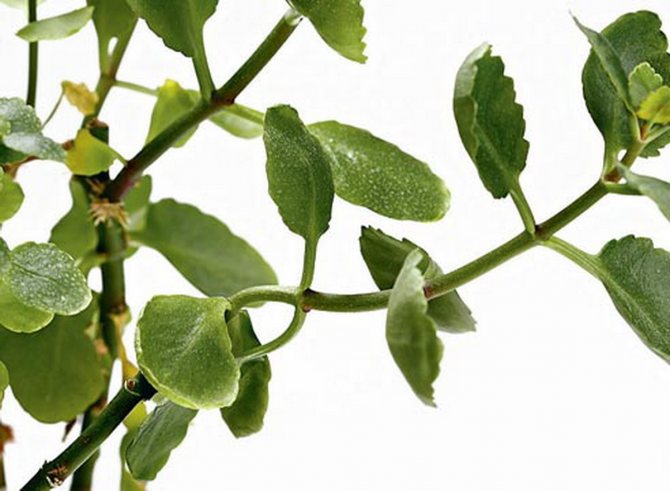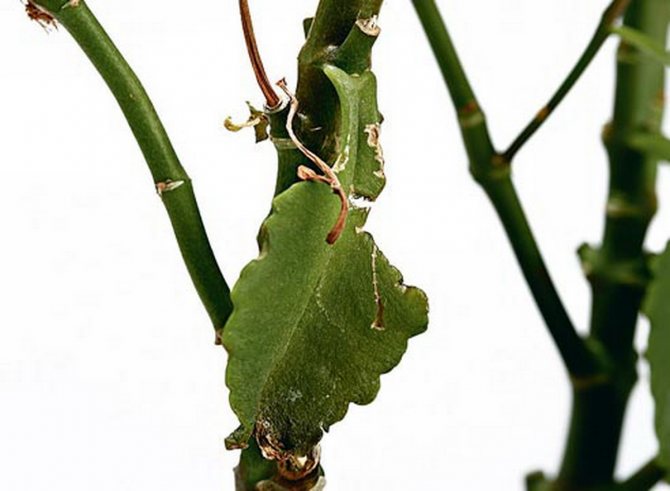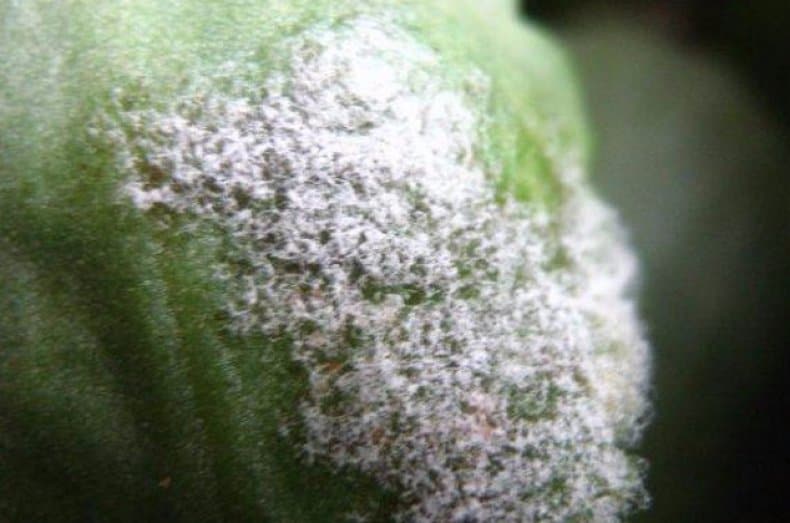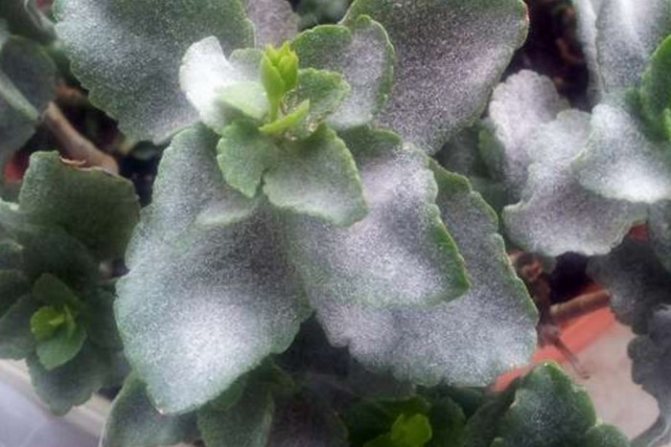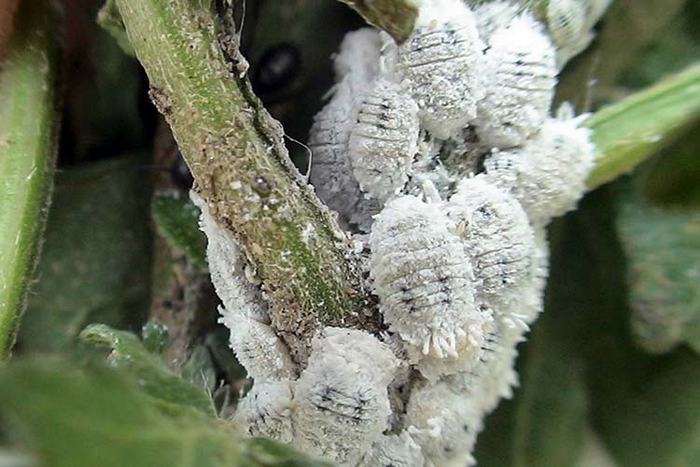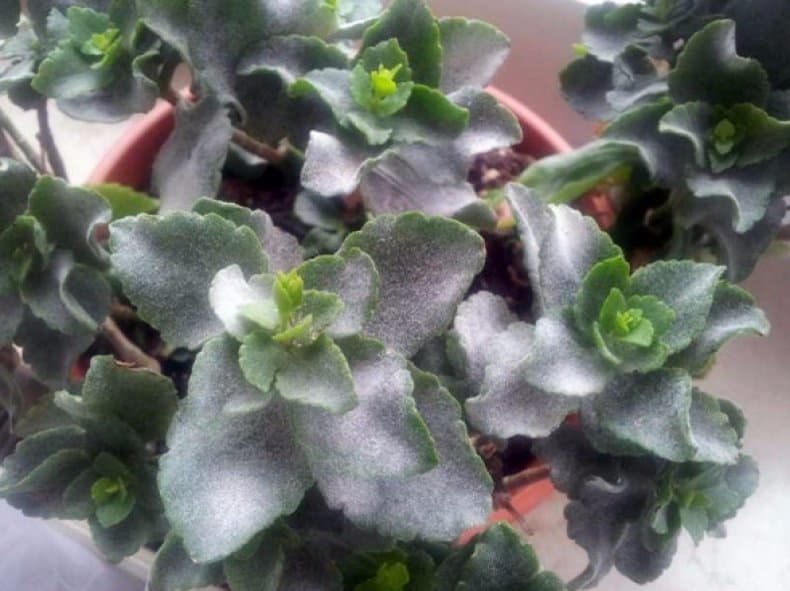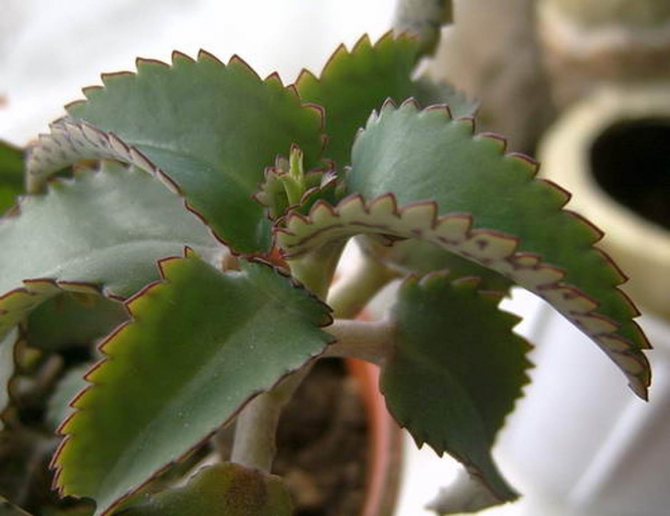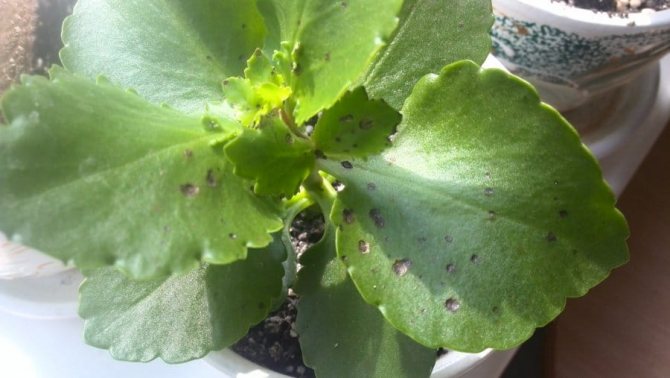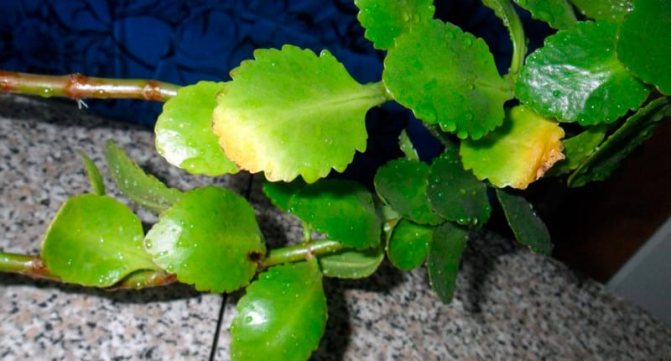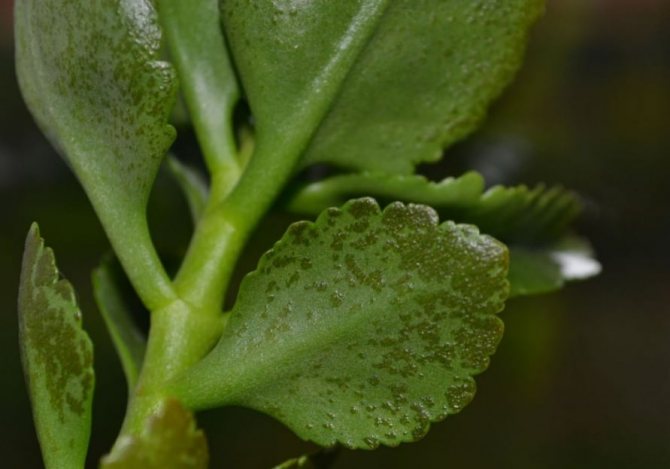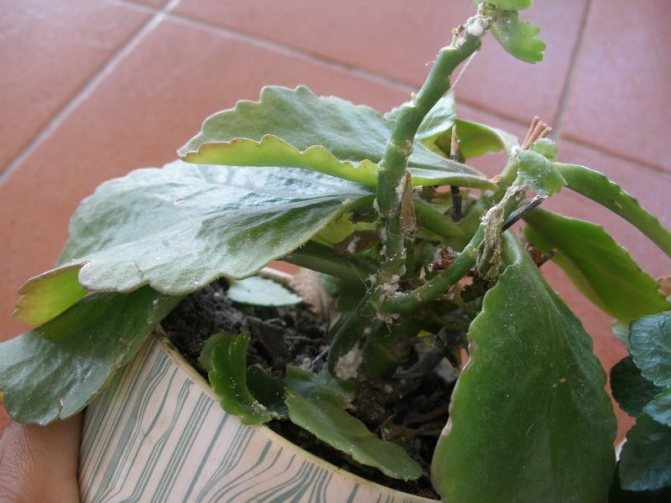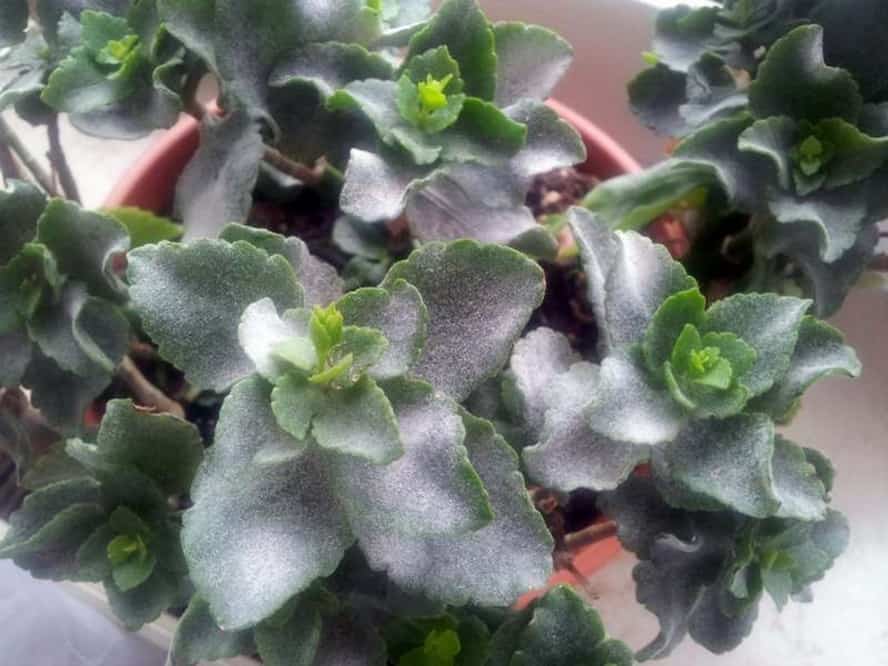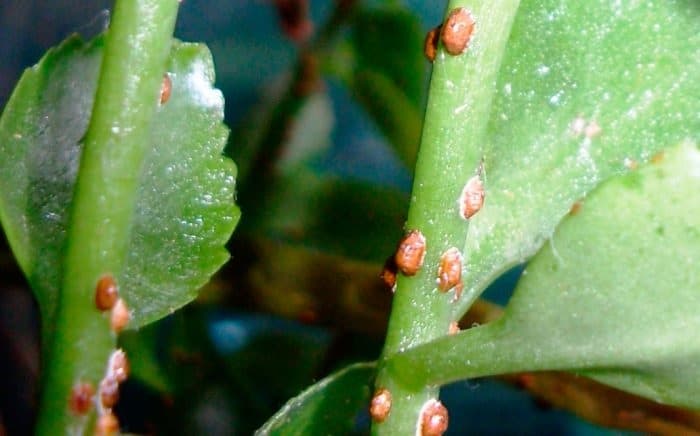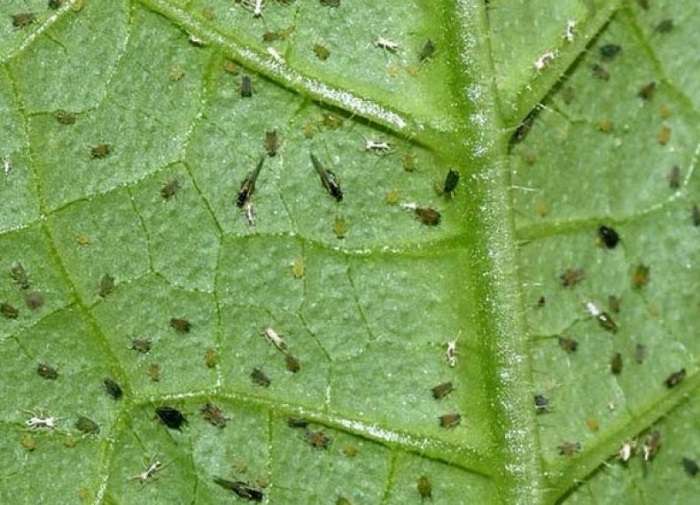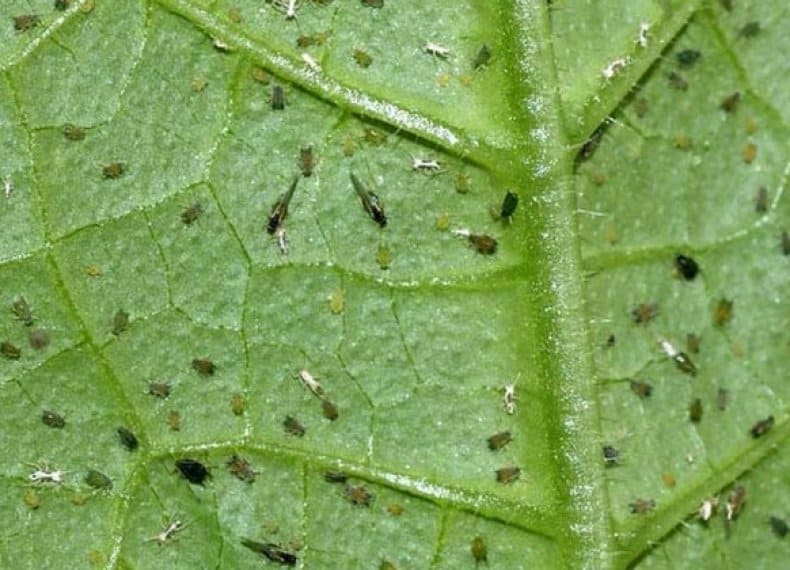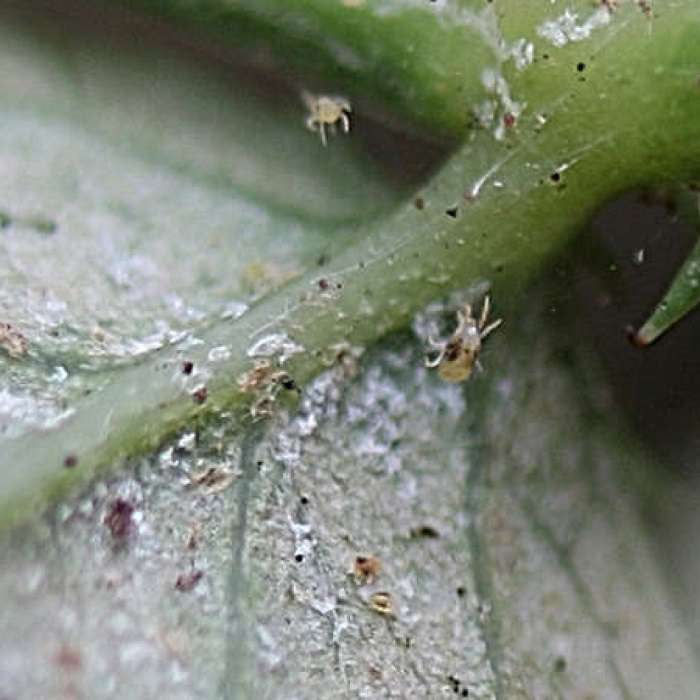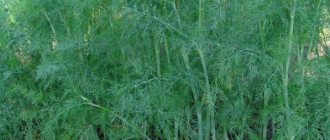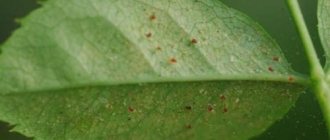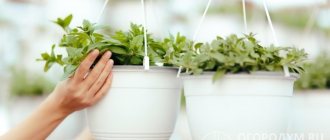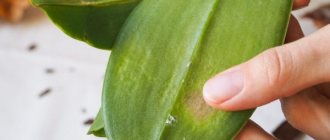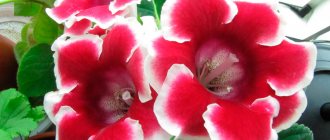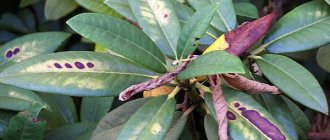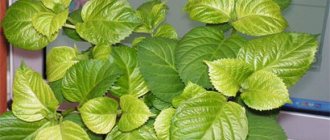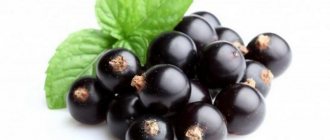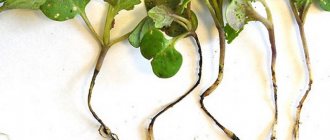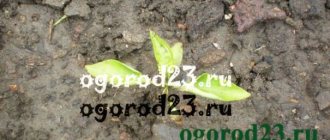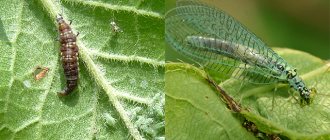Why Kalanchoe has problems with leaves
- When lack of light the plant is strongly stretched upward, so you need to move it to a brighter room or provide lighting. For the same reason, the lower leaves of the Kalanchoe turn yellow and their tips dry, as can be seen in the photo;
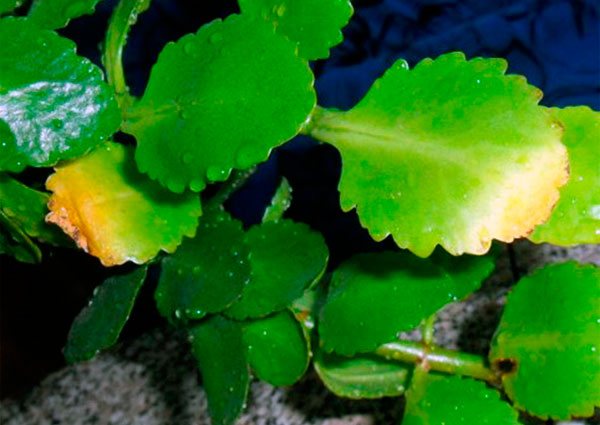
- Stale air indoors often leads to the fact that Kalanchoe leaves fall off. It is necessary to carry out regular ventilation;
- Spots on the sheets can appear from severe crowding, as well as due to sunburn. It is necessary to place the pots at a considerable distance between them and shade;
- Kalanchoe stops growing and sheds leaves due to lack of nutrients, especially after flowering ends. In this case, you need to transplant the plant into nutrient soil or feed it;
- If the leaves of the Kalanchoe curl, then there is a lot of peat in the soil or an excess of nitrogen. It is necessary to transplant the Kalanchoe into a properly prepared substrate, how to do this can be read here.
- The soft leaves of the Kalanchoe and their falling off may indicate over-watering or root rot infestation. It is necessary to reduce watering or carry out appropriate treatment of the root system;
- An excessive amount of direct sunlight can lead to the fact that the Kalanchoe turns completely yellow;
- If the Kalanchoe dries or its leaves wither, this indicates a prolonged lack of watering, the presence of pests in the soil or the wrong composition of the soil.
How to protect the Kalanchoe from falling leaves?
To prevent drying and falling of foliage in Kalanchoe, observe preventive measures and exclude provoking factors.
Light intensity
Blooming Kalanchoe should be provided with good lighting. However, do not expose to direct sunlight. Place the flower on east or west facing windows. And after blooming for about 2 months, keep the pot in the shade, but not in complete darkness.
Important! Do not place Kalanchoe close to window glass. Glass reflects the sun's rays and can burn leaves.
Maintaining the temperature and humidity of the air in the norm
It is equally important to observe the temperature regime required for the Kalanchoe and a sufficient level of air humidity. In summer, the ideal temperature is + 18 ... + 20 ° С, and in winter - + 14 ... + 16 ° С. Make sure the room is not damp or too dry. If the air is too dry, it is advisable to use humidifiers or periodically spray water on the flower.
Proper watering
The soil under the Kalanchoe should not be excessively wet, try not to flood the flower. Do the next watering only when you notice that the soil is dry. In the warm season, moisture should be more frequent than in the cold season. Water only with settled soft water.
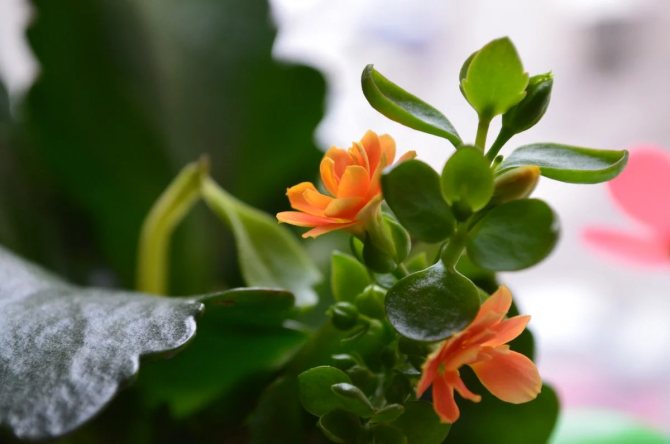

Finally, we will give a few more important tips from professional flower growers regarding the prevention of leaf fall in Kalanchoe:
- feed the flower with complex mineral fertilizers immediately after flowering;
- do not apply too much nitrogen fertilizer to the soil;
- disinfect the substrate before planting;
- so that the plant has the opportunity to actively develop, transplant it into a larger pot in time;
- when working with soil, use only clean tools;
- take care of a well-ventilated room for the plant;
- inspect the plant from time to time for the presence of parasites in order to take timely measures to combat them (pay special attention to the back of the leaf plates).
Important! An important role is played by the care of the Kalanchoe in the autumn-winter period. Even minor deviations from the rules at this time are fraught with shedding of foliage.
Drying and falling of leaves in Kalanchoe is a serious problem, which can only be dealt with by clearly determining the cause of the phenomenon and taking the necessary measures. Following the above recommendations, you will quickly cure the plant, and it will again begin to delight with its flowering appearance.
The main diseases of Kalanchoe and their treatment at home
Late blight rot
Late blight rot is a fungal disease. Its appearance can be identified by brown spots in the branches of the shoots. The plant is greatly inhibited in growth.
Infection can be caused by overflow, high air temperature indoors, lack of ventilation and excessive nitrogen content in the soil. Sudden temperature changes contribute to the rapid development of the disease.
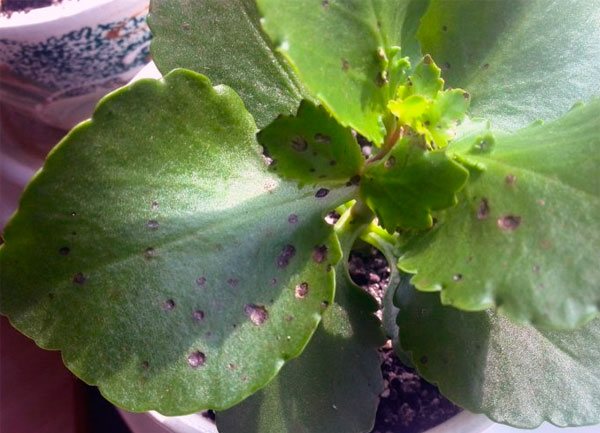

Treatment of late blight rot is carried out with the help of fungicides, while watering is sharply reduced, if possible, you need to replace the soil. As a preventive measure, it is necessary to decontaminate the soil before planting Kalanchoe, use clean tools and conduct regular inspections of plants.
Gray rot
When infected with gray rot, the Kalanchoe becomes covered with a gray bloom and weeping spots. Over time, the plant completely rots. The disease spreads very quickly to healthy plants with air, tools and direct contact. The development of the disease can be triggered by excessive moisture in the air and soil, lack of ventilation, spraying or poor lighting. If an infection is detected, the Kalanchoe should be treated with a fungicide.
Powdery mildew
Powdery mildew manifests itself by the formation of a powdery white coating on the leaves of the Kalanchoe. Gradually, they begin to die off. The active development of the disease is promoted dryness and high temperature air. With timely measures taken, the disease does not cause severe harm to the Kalanchoe. The treatment is carried out by spraying with fungicides.
How to find out that a spider mite has settled on a plant, and how to deal with it, read here.
And here you will find the answer to the question why the leaves of anthurium turn yellow.
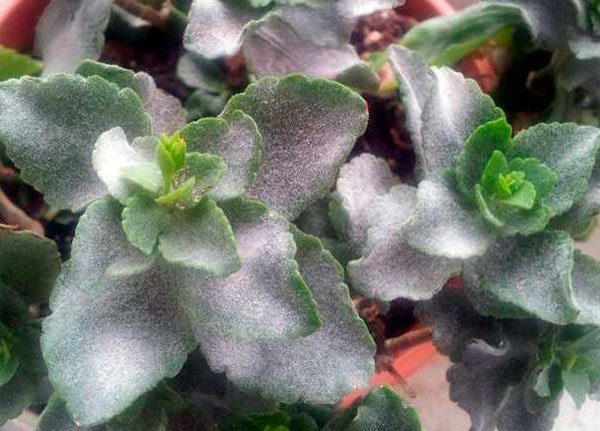

Stem rot
The appearance of black watery spots on the foliage and stems indicates an infection of the Kalanchoe with stem rot. The disease develops in conditions of high humidity. If spraying with insecticides does not help, then you need to destroy the diseased plant.
The main diseases of Kalanchoe
Diseases on the plant appear due to inappropriate care. Kalanchoe may need additional lighting, fresh air, mineral fertilizers and moisture. Often, the opposite is also the cause: sunburn - from prolonged exposure to direct rays, decay of roots - from excessive watering, an excess of peat and nitrogen in the soil. Depending on the cause, this or that disease manifests itself.
Late blight
The disease often attacks garden plants and useful crops, but also manifests itself in indoor flowers. The fight against it requires a complex one, since complete elimination will require more strength than in the case of powdery mildew or gray rot.
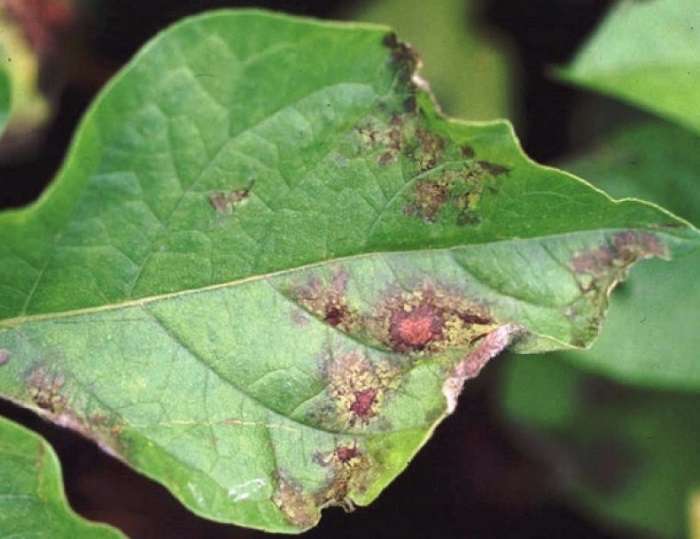

Brown spots appear on the leaves of the Kalanchoe, which over time grow throughout the plate and begin to turn black. In the future, the stems will also be affected, all plant tissues become soft, rotten. Late blight is characterized by a high spreading rate and a negative effect on the roots. When the disease gets to the root system, the flower can be easily removed from the pot.
The cause of the appearance may be improper care: frequent watering, prolonged presence of moisture in the root system, too dense or inappropriate soil. Also, the disease can be brought in through rainwater.
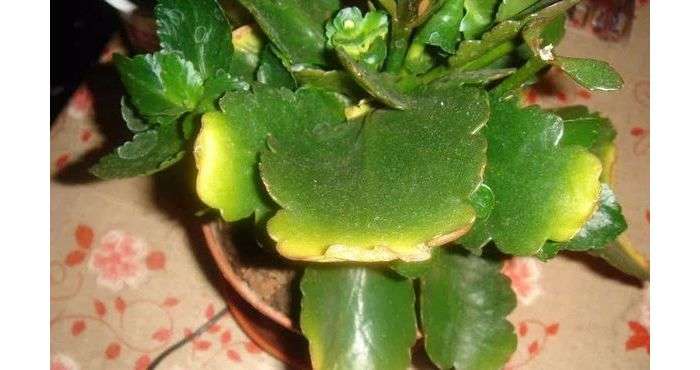

Control measures are to remove damaged sheets with treatment of the cut point with activated carbon. Spraying is carried out at the time of extraction from the substrate, followed by transplantation into a new pot. Potassium permanganate (1.5 g) is diluted in 5 liters of water. However, it is best to use modern store-bought fungicides.
Powdery mildew on Kalanchoe
The disease manifests itself quite often and many gardeners are familiar with its external manifestations. A warm (above 21 degrees) and humid room with a dense arrangement of plants becomes favorable conditions for the appearance of a fungus. A white bloom appears on the leaf plate.
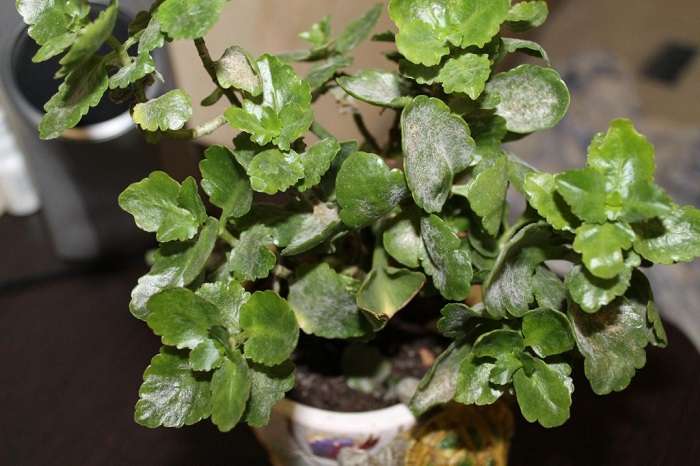

If the temperature and humidity are lowered, the mycelium will begin to die, leaving behind damaged leaves with spots of dead tissue. Eventually, they will dry out completely, curl up and fall off. The plant itself will produce deformed flowers or stop blooming completely. Powdery mildew is easily transported to other plants with the help of water and wind. To prevent this from happening, watering must be done carefully, without splashing moisture.
Interested in what to do when a white bloom has formed on the leaves on the Kalanchoe, it is necessary to exclude stagnation of moisture. The introduction of the liquid should be done strictly at the root so that drops do not fall on the leaves and stems. Also you will need to provide the flower with sufficient space so that air can circulate well, ensuring drying.
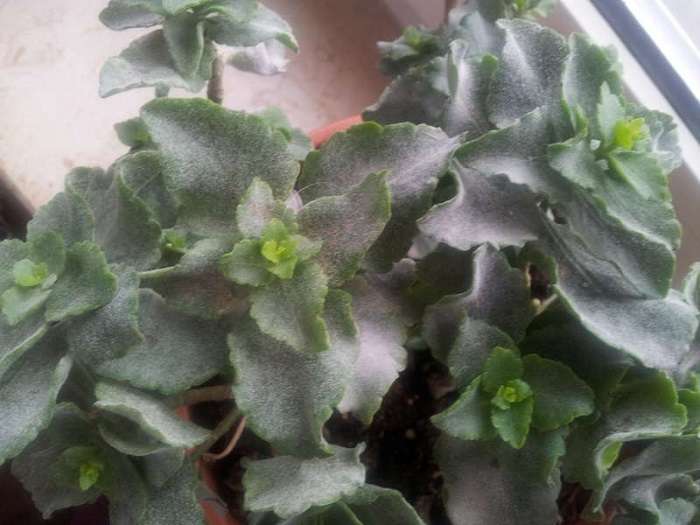

Direct treatment consists of spraying with fungicides 3-4 times in the interval of 7-10 days. Alternatively, biological products are used: Biosept (0.1 ml of substance per glass of water), Bioczos (5 ml per glass).
Stem rot
This disease manifests itself after frostbite. The main trunk and stems extending from it turn black, the leaves wither. As such, there is no treatment for the disease, it is only required to provide the correct conditions of detention. The optimal temperature in winter for a flower will be in the range of 15-20 degrees.
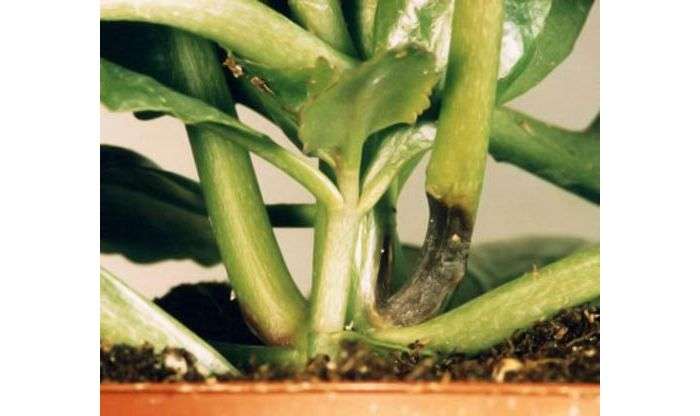

Given the cool conditions, watering should be reduced accordingly. Non-evaporating moisture can cause decay of the rhizome, which can lead to complete death.
Gray rot
This disease is triggered by a fungus called Botrytis cinerea. It is often found on indoor plants, affecting all areas. The risk of infection is especially high in flowers that were previously weakened by transplanting or lack of nutrients in the soil.
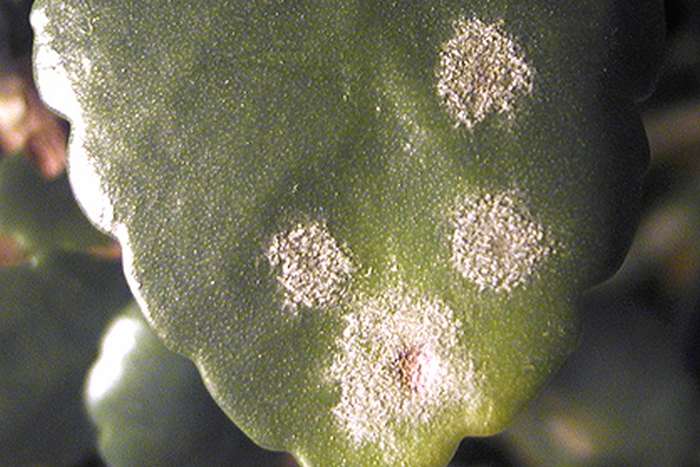

It appears as a gray bloom on the leaves of the Kalanchoe, reminiscent of dust collected in round piles. Before the appearance of the main symptom, brown spots of a watery consistency can be seen at the base of the stems. After infection, everything above it dies off.
A humid environment is a great place for gray mold to develop. Avoid getting the plant wet while watering. If the plant sheds the lower leaves, then they must be removed from the soil surface in a timely manner. Decaying plant debris is the focus of the development of fungal spores. With the onset of cold weather, watering is best done in the morning, so during the day the top layer of the earth can dry out enough.
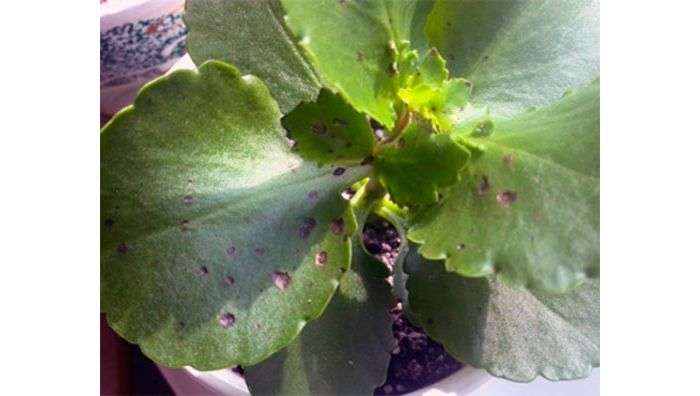

Treatment consists in carrying out two sprays, which are performed with a pause of 10 days. Suitable drugs Teldor, Miedzian 50 WP, Biosept. Read the instructions before use.
Ring spot
Considering the diseases of Kalanchoe leaves and their treatment, one cannot fail to mention spotting. It manifests itself in the form of small spots with a diameter of 1-3 mm. Their color changes from yellow to brown during development. The disease is caused by a fungus and has a long developmental period.
The spots that appear do not increase for a long time, but subsequently merge into larger foci, piercing the leaf plate through and through. Further, the leaves turn yellow, crumble. Spores are carried to other plants by water droplets or insects.
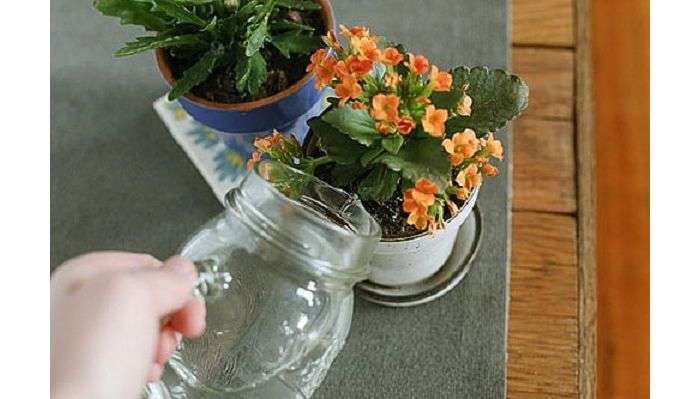

As in previous cases, it is required to control the humidity of the environment and the soil itself. Water should not linger on the leaves, if necessary, wipe with a dry cloth. The pot is moved to a place with good air circulation. Fallen leaves are removed. Spraying is carried out in 2 stages with the biological products indicated above.
Pests affecting Kalanchoe
Multi-claw mites
When mites of different claws appear on the Kalanchoe, the leaves and petioles are covered with a brown scab. Plant tissues harden and bend. The foliage stops growing, and its edges begin to curl inward.
When inspecting the plant, you can see that small white glassy mites have settled on it. They appear in damp rooms with high air temperatures. If parasites are detected, wash them off with soapy water and carry out further treatment with insecticides.
If aphids appear on the Kalanchoe
When damaged by aphids, Kalanchoe turns yellow, the leaves are deformed and covered with sticky secretions of parasites. Over time, they fall off, and the buds do not dry out unblown. Most often, infection occurs in the spring.
Besides being aphids are the most dangerous pests for Kalanchoe, they quickly colonize neighboring plants. They suck plant juices from flowers, injecting their own poison into them, and the sticky substances they release clog the pores of the plant and prevent them from breathing.
If small green or black insects move along the shoots and inflorescences, urgent measures must be taken to destroy them. This is done by treating the plants with a solution of green or laundry soap and spraying them with insecticides.
Aphids enter the premises, as a rule, with newly acquired plants. Therefore, before placing them in the house, you need to arrange quarantine for them, keep them separate from the rest for several weeks and observe their condition.
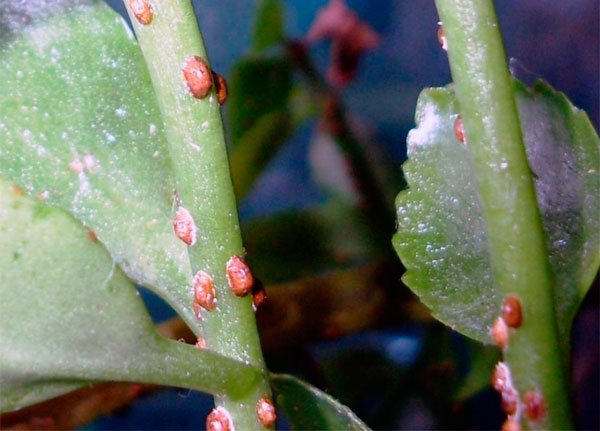

Mealybugs
When Kalanchoe is affected by mealybugs, the veins of the leaves and petioles are covered with a white waxy bloom, in which the parasites live. During treatment, first of all, severely affected parts of the plant are removed, and then treatment with an insecticide or special mineral oils is carried out.
Shield
The scabbard in appearance is similar to aphid with a wax shell, while it also sucks all the juices from the plant. This leads to the fact that the leaves turn yellow, fall off, plant growth and flowering cease.
Its surface is covered with a sticky bloom (pad), on which the development of a sooty fungus begins. Infection occurs, as a rule, in dry and stuffy rooms.
The difficulty of dealing with an adult scale insect lies in the fact that the wax shell reliably protects it from chemical attack. Therefore, along with this, mechanical methods must be applied. To do this, remove insects from the plant with a cotton swab or a soft brush dipped in alcohol. Then you can spray with any insecticide.
Why gardenia leaves turn yellow can be found in this article.
The most common geranium diseases and methods of dealing with them.
Since there are a lot of diseases and pests that affect the Kalanchoe, the observance of the rules for caring for it and timely preventive measures for this plant are simply necessary. They are quite capable of saving you and your pet from many problems.
Kalanchoe not only acts as a room decoration, but can also help in the treatment of many ailments. Unfortunately, sometimes the flower itself needs human help. Diseases can manifest themselves in the form of a change in the color of the leaf, its drying and falling off. Not without pests that attack the plant, sucking the juice out of it. In the current article, we will consider Kalanchoe diseases, provide their photos and treatment methods, and also show you how to deal with insect pests.
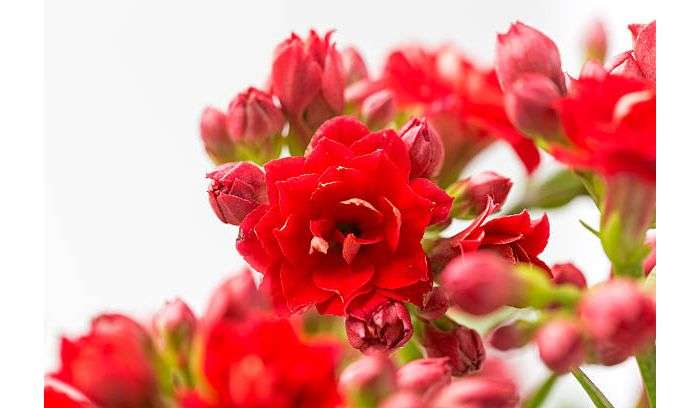

How to revive Kalanchoe?
If your pet is badly damaged and in this form is no longer pleasing to the eye, you need to restore it. There are several ways:
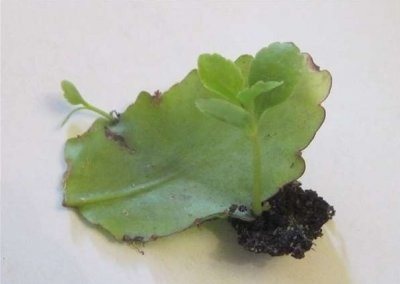

Rooting the tops of the shoots. The crown of the shoot is cut off with a sharp knife, the cut is treated with a solution of the drug "Kornevin" and placed in wet, crushed sphagnum or sand.- Topping. Adult Kalanchoe often stops blooming and becomes nondescript. In this case, you need to remove the shoots on which there were flowers.
After the young shoots begin to grow, pinch 2 leaves on them. Removing the tops helps to stimulate the formation of young growth. If the shoots are bare at the bottom, but look normal from above, cut off the bare top and root it. You can put the crown in water, or you can immediately plant it in fresh soil and water it abundantly.
The plant will look lethargic at first, but when roots form on it, it will regain its elasticity and begin to develop. Once this happens, cut back on watering.
Choose the optimal place for its existence, follow the care recommendations, do not allow damage by insects, and it will thank you with a long and very decorative flowering.
If you find an error, please select a piece of text and press Ctrl + Enter.
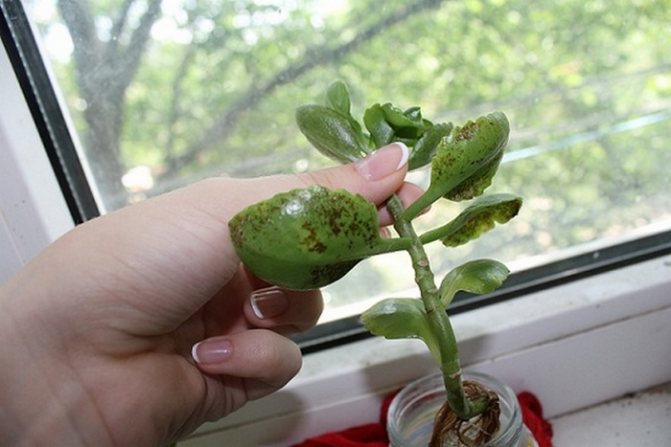

Photos and descriptions of Kalanchoe leaf diseases, yellowing of leaves, spots on the leaves, gray rot, powdery mildew, mealybugs.
Kalanchoe blooming in winter can suffer from diseases associated with improper care or the attack of pathogens. The main problems are yellow leaves, disfiguring spots or white bloom covering various parts of the plant. Learn how to fight Kalanchoe diseases, what to look for when caring for plants, what to do to make the Kalanchoe look beautiful again.
Why Kalanchoe sheds leaves
The problem of leaf fall deserves special attention. Such a nuisance is not associated with diseases, but refers to the wrong content. So, shedding of leaves can occur for the following reasons:
- Lack of sunlight. A flower located in the back of the room will ache and lose foliage, since enough natural light does not reach there.
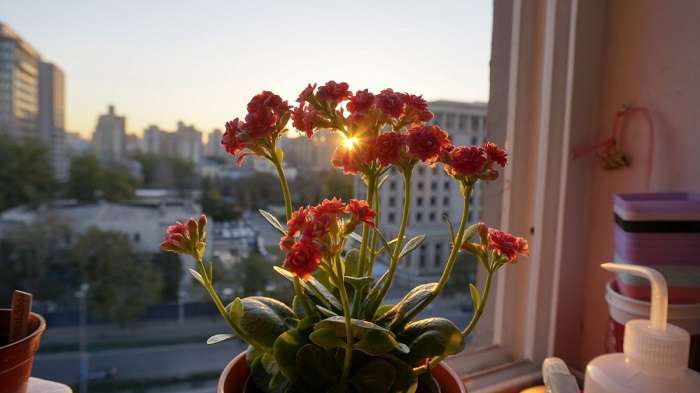

- Weakening after flowering. To help the plant, you need to fertilize according to the current season.
- High temperature and dry air. Most often, the problem is observed during the period when the central heating is turned on, when the Kalanchoe is located on the windowsill. Move it to a cooler place, lower the temperature in the room and increase the humidity. However, it is required to monitor watering so that there is not too much moisture in the pot.
- Old shoots are not cut off. It is important to update the plant in a timely manner, giving way to young shoots.
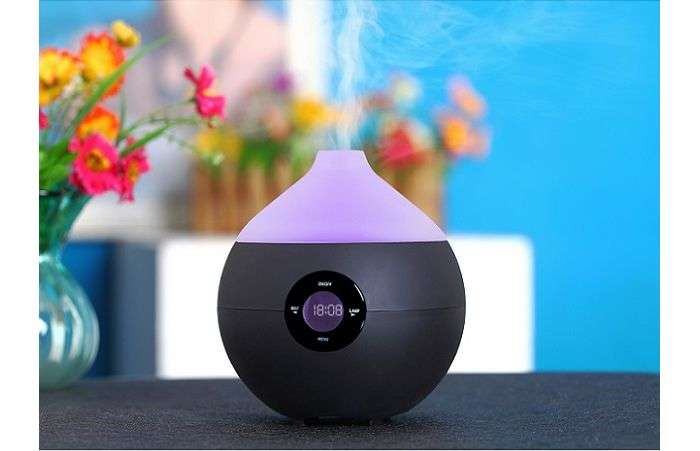

Causes of leaf fall in Kalanchoe
The main reason for the sudden fall of foliage in the Kalanchoe is the incorrect maintenance of the culture during the dormant period (from October to February). Kalanchoe does not tolerate high or too low temperatures, as well as dry warm air. Trouble can occur when the flower is in a stuffy place, for example, next to a heating source.
Did you know? In the Old World, the healing characteristics of the Kalanchoe were not known until the middle of the 20th century. As a medicine, the flower was first investigated and tested by Ukrainian medical scientists.
Kalanchoe sheds leaves for a number of other reasons:
- Excessive watering. Due to the fact that the Kalanchoe can accumulate moisture in the leaves, overflow of soil is fraught with weakening and falling foliage.
- Insufficient watering. The flower reacts in a similar way to prolonged drought.
- Errors in lighting mode. The fall of only the upper leaves indicates a lack of sunlight. Uniform drying along the entire length signals an excess of light.
- Pot size. If the root system does not have enough space in the container, soon the flower will begin to dry out.
- Poor water performance (high water hardness).
- Fungal infection and attack by insect pests.
Risk factors are also the poor-quality composition of the soil mixture, as well as the lack or excess of fertilizing.
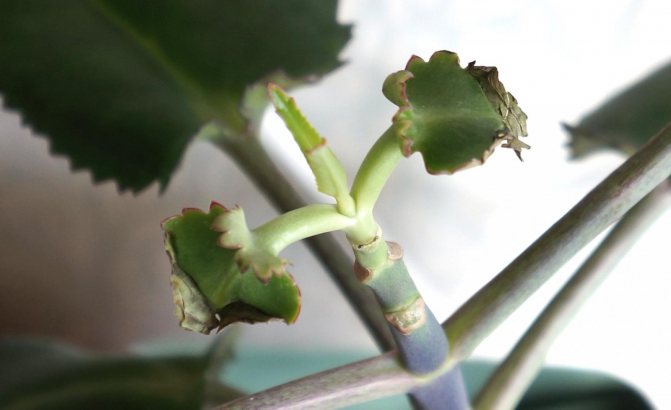

Kalanchoe pests
Pests on this flower appear much less often than diseases, but such a phenomenon still takes place. Among the pests of Kalanchoe, aphids, scale insects, ticks and mealybugs are distinguished. All of them suck the juice from the plant, weakening its strength and making it defenseless against other threats.
Mealybug
An insect of small size, which in the process of its vital activity deprives the plant of juice. The second negative factor is the spread of black mold. The development of the colony occurs quickly enough, therefore, if measures are not taken in time, the Kalanchoe will die.
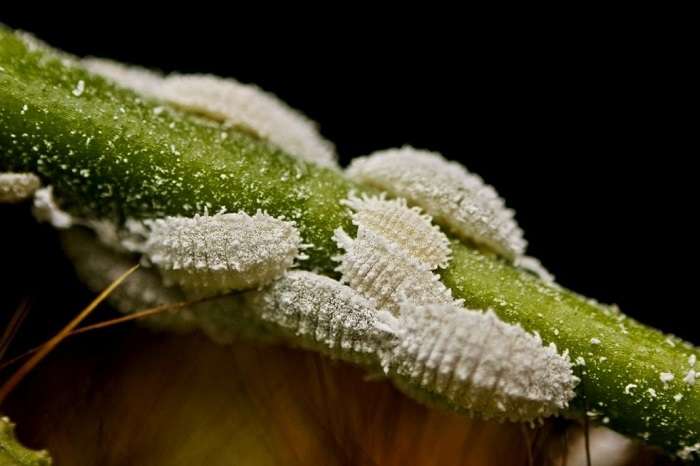

A characteristic sign of the presence of a pest is a waxy coating present on the leaf blade and stems. The fight is to apply a mineral oil spray. If one of the branches is heavily infected, then it is better to remove it. It is important to check the plant and soil before purchasing for the presence of pests.
Shield
The insect has an oblong body, covered with a shield. Males are smaller than females, which, in principle, do not move, but only cover their eggs. A characteristic sign of the appearance of a pest is plaque and the individuals of the scale insect themselves, since they are large enough in size and are clearly visible with the naked eye.
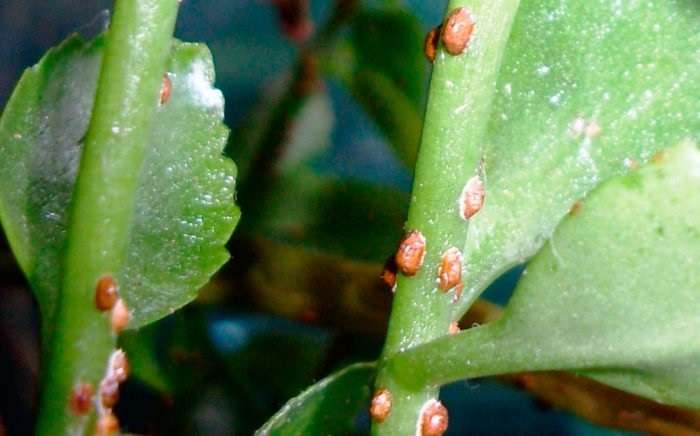

The spread of the scale insect on the plant is the reason why the Kalanchoe withers. In the future, the leaves will turn yellow and fall off, the flower will slow down its growth, stop throwing out peduncles. The presence of this pest can provoke the appearance of a sooty fungus, which will further exacerbate the situation.
The fight is to spray the plant frequently, as scale insects do not like water. Adults are treated with alcohol to improve separation from the leaf, then harvested. After that, the flower is sprayed with soapy water. Pest control insecticides can be used instead. Generally acting drugs are suitable, since there are no separate developments.
Possible pests and diseases of the plant and how to deal with them
Insects and diseases can provoke the shedding of Kalanchoe foliage. Let's consider methods of their elimination.
Aphids on Kalanchoe
Aphids are an insidious pest that intensifies activity in the spring season. It is a carrier of more than 100 types of pathogenic microbes. A flower infected with aphids turns yellow, then loses its foliage. With a severe form of infection, the death of the plant is not excluded.
Did you know? The inclusion of Kalanchoe in the list of medicinal plants was preceded by a case. In the 60s of the XX century, a letter from a small village came to Kiev Medical University, where a resident shared that he received an unusual plant as a gift that could heal wounds. After this letter, the study of the medicinal properties of the Kalanchoe began.
Initially, you may not even suspect the presence of an insect, because it settles on the back of the leaf plate. But already settled colonies of small green or black individuals can be easily seen on young shoots and inflorescences. The presence of aphids is also evidenced by the sticky mass covering the foliage and stems. Parasites love Kalanchoe juice, they inject a toxin into the plant, thereby poisoning it.
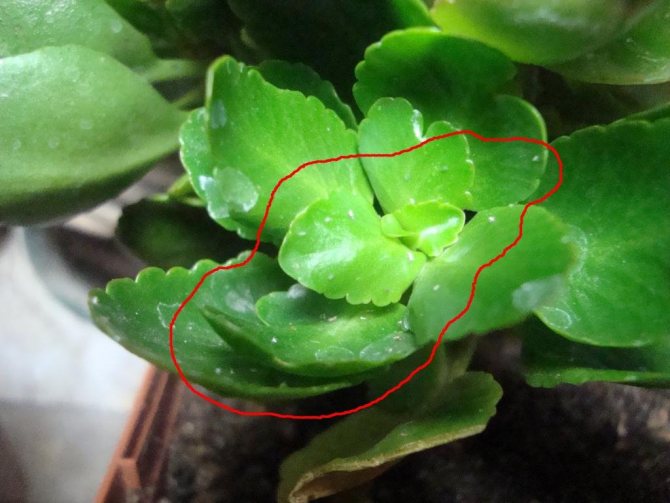

If urgent measures are not taken, the pest can spread to nearby crops. To remove aphids, first remove all affected parts, and treat healthy parts once a week with an insecticide such as Aktara, Iskra, Commander or Confidor. After a month, the problem should be resolved.
The plant can be cured with such a folk remedy as green potassium soap. To do this, dilute 20 g of soap in 1 liter of water. Wrap the soil in a plastic bag, and rinse the aerial part of the plant with soapy water.
Shield and false shield
Shield - a harmful insect with an elongated miniature body covered with a protective wax shell. Females are larger than males and lack legs and wings.
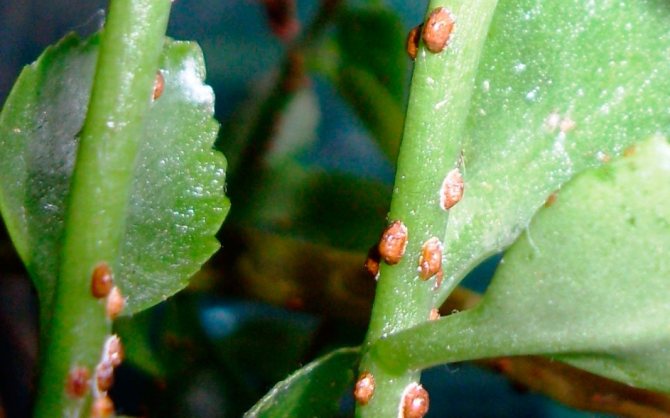

False shield from the real one is distinguished by the absence of wax shields. Eggs and larvae are protected by the dying female's drying skin.
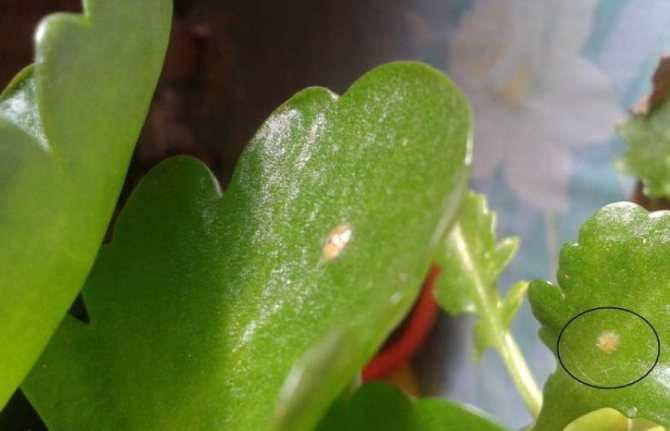

The larvae of the pest spread throughout the plant in just a few hours after hatching. Located on the underside of the leaf plate, the parasite sucks the juices out of it. Adult scale insects and false scale insects are usually motionless, while young ones like to move. Visually, the colonies of this insect look like plaques on the Kalanchoe.
The first step is to clean off parasites. Use a toothbrush for this. It is also recommended to wash the plant with soapy water, then carry out treatment with an insecticide such as "Oksikhom", "Tsineb", "Tiram".
From unconventional means, wiping with a cloth soaked in diluted alcohol will help (repeat the procedure 3-4 times a week). Garlic infusion is also effective, the basis of which is 5 cloves of a vegetable and 200 ml of water. The composition should stand in a dark place for 2 hours, after which it must be filtered. The green part is sprayed with such a liquid until the scabbard is completely eliminated.
Also read why Kalanchoe leaves turn yellow.
Other pests and diseases
In addition to the above, the flower can be bothered by such harmful insects as multi-claw mites and mealybugs. The former cover the surface of the leaves with a brown scab. Small glassy specimens can be washed off with soapy water. Then treat the flower with an insecticide (Aktara, Aktofit, Akarin, Fitoverm, Mospilan, Fufanon).
Similar chemicals work against mealybugs, which cause a white waxy coating on the foliage. Treatment with mineral oils is also effective.
The most formidable Kalanchoe diseases leading to foliage are:
- Stem rot... Watery black spots appear on shoots and leaves. If the humidity in the room is too high, the disease spreads faster. You can treat the flower with an insecticide. If there is no improvement, the diseased specimen should be disposed of.
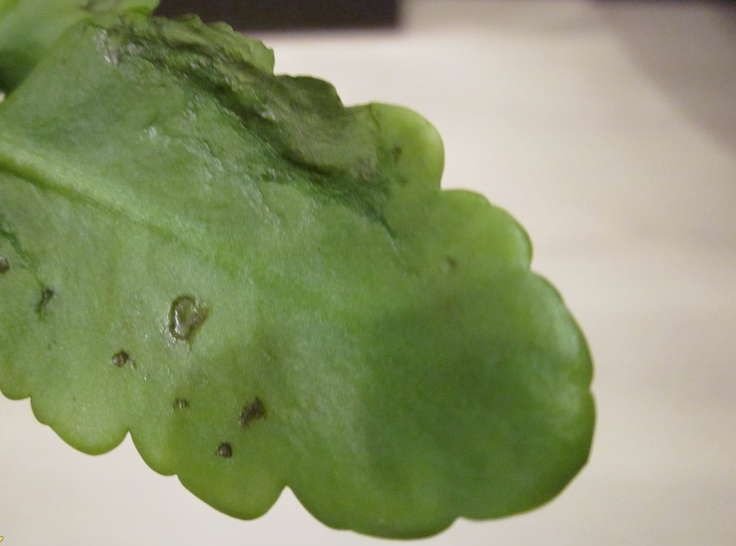

- Annular leaf spot... The disease leads to the formation of a mosaic pattern on the leaf plates. Ring spot cannot be cured, so the affected area should be removed.
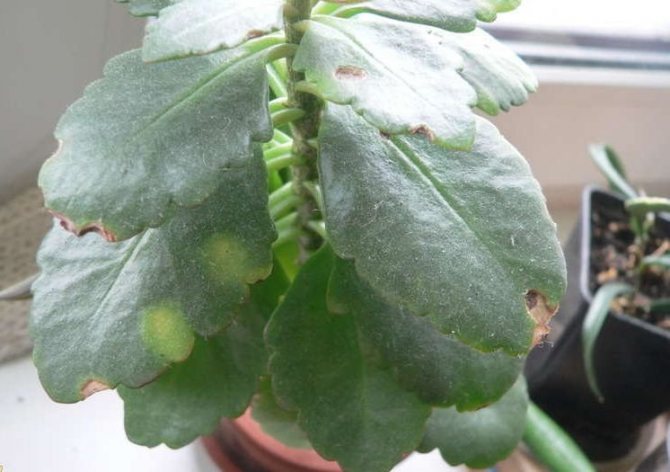

- Late blight... Fungus, manifested in the form of brown spots on the branch of the shoots. They are treated with the use of chemical ("Oxyhom", "Tsineb", "Tiram") and biological ("Agat", "Alirin-B", "Albit", "Baktofit", "Barrier", "Planzir", "Trichodermin") fungicidal drugs. In addition, it is advisable to replace the soil with a new one and reduce watering.
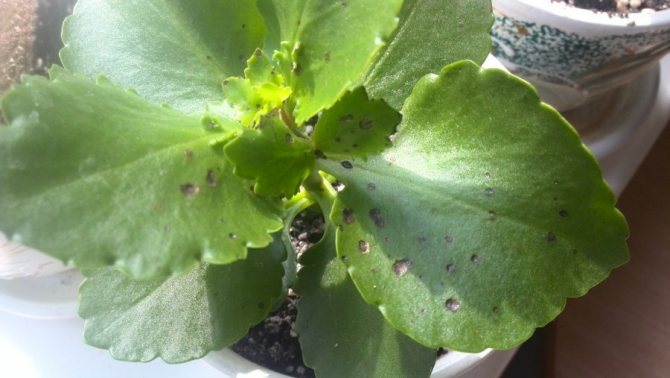

- Powdery mildew... If the foliage is covered with a white powdery coating, then the flower is infected with powdery mildew. In case of inactivity, the leaves will inevitably begin to fall off. Effective treatment with fungicides such as "Skor", "Tilit", "Topsin", "Fundazol", "Quadris". Natural preparations (Gamair, Planzir, Fitosporin-M) also have a good effect. You can also fight powdery mildew with folk remedies: spray the plant with a mixture of soda ash and soap with soda or wood ash mixed with boiling water and grated laundry soap.
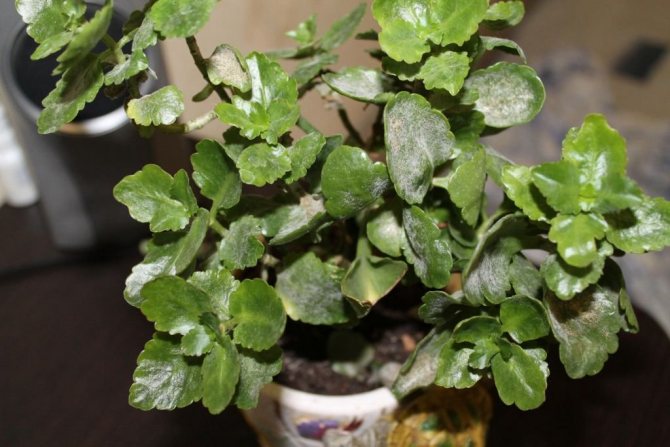

- Gray rot... It is manifested by a gray bloom and weeping spots on the green part. The disease usually spreads to neighboring flowers. Kalanchoe requires treatment with a bacterial preparation (for example, "Alirin-B" or "Planriz"). An effective folk remedy is spraying with a solution of potassium permanganate (dilute 2.5 g in 10 liters of water). Perform several treatments at intervals of 7-8 days.
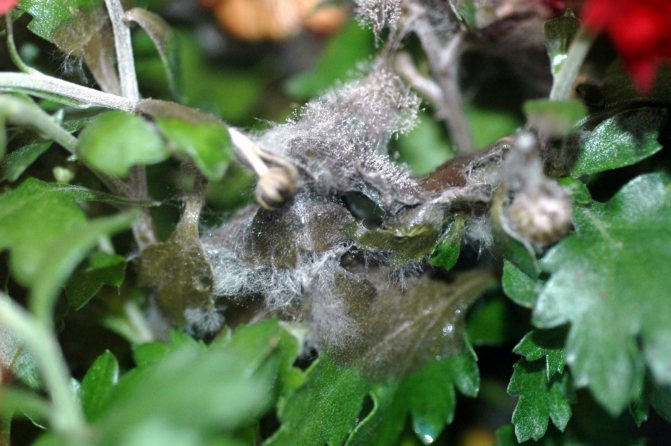

How to reanimate Kalanchoe
Having coped with the original source of the problem, the plant needs to be reanimated and sent for further development. As a preventive measure, drafts, temperature changes, excessive moisture or overdrying are excluded.
In order for the plant to regain its strength, it needs proper care:
- Watering is carried out in small doses at intervals of 1 every three days.
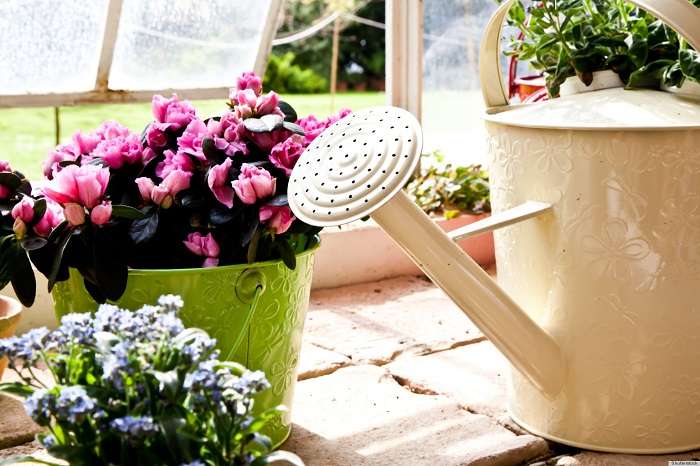

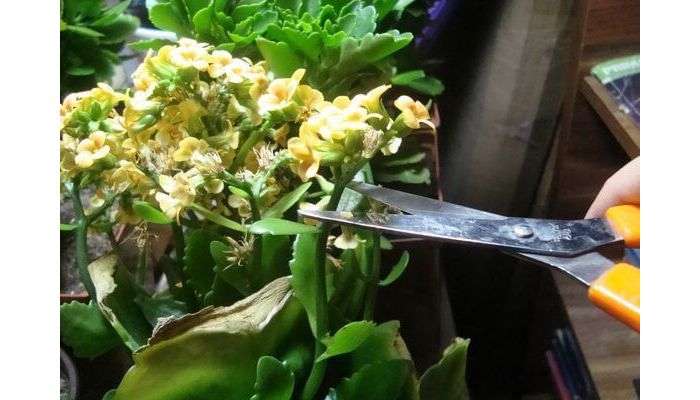

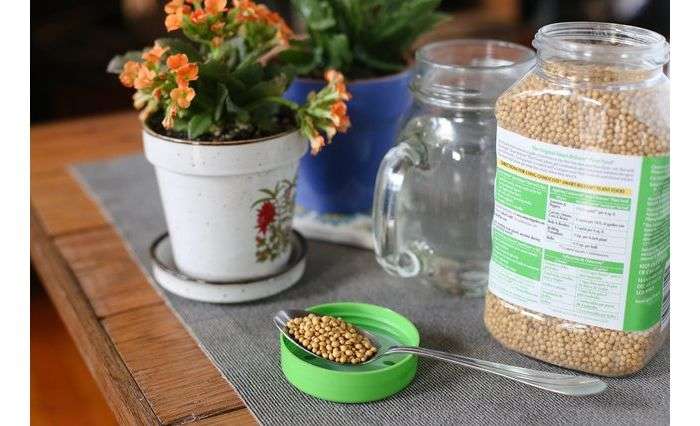

Knowing what diseases and pests attack the Kalanchoe, it will be possible to react in time to the deterioration of the plant's condition and take appropriate measures. It is important to regularly conduct inspections and monitor the external condition of foliage and shoots, they are the first to signal trouble. After eliminating the problem, the flower should be reanimated. In the future, you will also need to adhere to the rules of care, because such a "home doctor" will come in handy in every family.
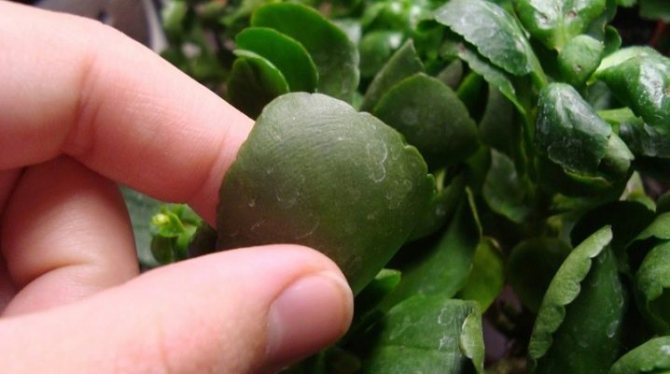

Kalanchoe is a calm flower that responds well to leaving. But he is also susceptible to diseases that can be easily "viewed". If you are a novice florist, then do not wait until the deterioration in the appearance of the Kalanchoe grows, carry out a diagnosis and start treatment. How exactly the flower is sick, how it is expressed, and how to help the plant, we will tell you point by point.
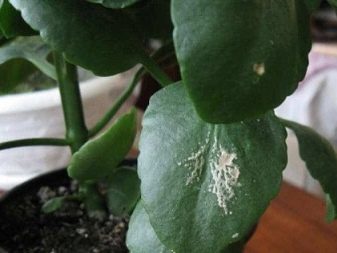

Correct care
For more details on how to care for the Kalanchoe so that it blooms, read here, and here we talked about how you can achieve its abundant flowering after purchase.
This is how you need to take care of the Kalanchoe flower at home.
Kalanchoe is a delicate plant that requires your care. If you provide it and pay constant attention to it, then the flower will delight you with its beauty and health.
Symptoms and Causes
By the symptomatology, you can determine what kind of ailment struck the flower. The signs are usually bright, it is difficult to confuse the disease if the symptoms are severe. In search of the cause of diseases, be guided by the following list.
But not only diseases attack Kalanchoe. The leaves turn yellow and curl and from the attack of pests. If the tops of the plant are covered with black mold, and waxy discharge appears on the leaves and stem, this is a mealybug. If the flower has almost dried up in a short time, and its leaves are constantly curling, this is probably a scale insect. The leaves turn yellow from the tick, and if the Kalanchoe first turns yellow, and then throws off the leaves, it is probably necessary to fight with it.
To prevent the flower from withering, inspect it every day.
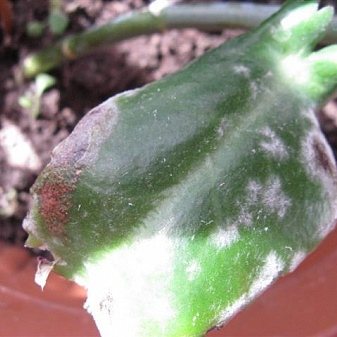

Yellow leaves
Yellowing of Kalanchoe leaves is more often the reason excess wateringleading to root flooding. In this case, watering should be limited, especially in winter, and the soil should be allowed to dry out. Kalanchoe does not require a lot of water. It is enough to moisten the ground every 10-14 days. Remove the water accumulated in the pan after 15 minutes so that the plant does not stand in the water. Do not water the Kalanchoe when the leaves are drooping, this means that the ground is too wet, not dry, as many people mistakenly think.
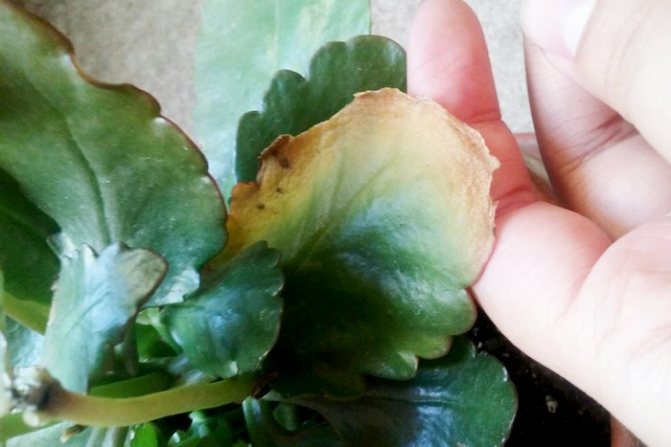

Adequate drainage must be provided in the pot. A layer of pebbles, expanded clay or crushed ceramics 2 cm thick is poured onto the bottom of the container. Drainage will facilitate the outflow of water, while preventing water from entering the root area.
Uneven watering, long periods of drought, then abundant watering leads to yellowing of Kalanchoe leaves. If you do not provide regular watering, you should choose hydroponic cultivation. Special pots are placed in a container for water, which the plant uses as needed. Installed water level indicators will tell you when to replenish its level.
Another reason for the yellowing of Kalanchoe leaves can be plant exposure to ethylene... Ethylene is a gas found in cigarette smoke and exhaust fumes and is also emitted by ripening fruits (especially apples). The solution is to move the pot out of the room where the cigarettes are smoked or the kitchen where the fruit is kept.
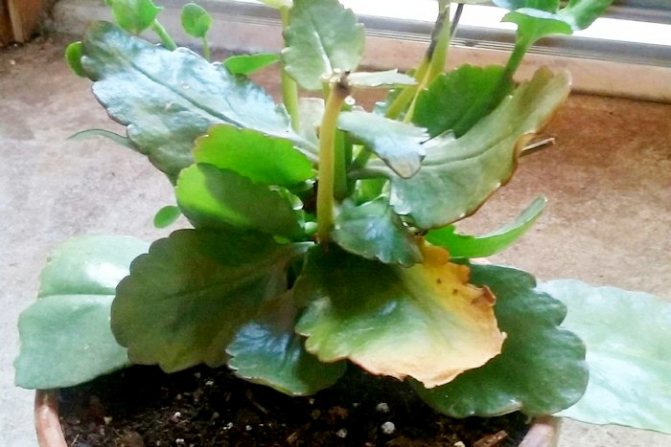

The lack of minerals in the soil is manifested by yellowing of the leaf blades. The flower is sensitive to zinc deficiency in the soil. When there is not enough zinc, the leaves between the veins turn yellow, lose their tone and become deformed. To prevent zinc deficiency, Kalanchoe should be grown in a substrate with a pH of 6.0-6.5, rich in peat and perlite. In flower shops, appropriate mixes are available for growing cacti and succulents.
Spots on the leaves
- Brown crusts on the leaves (dropsy)
Convex, light brown spots on the underside of the leaves indicate a physiological disease - dropsy. Dropsy is the result of growing a flower in conditions of high temperature (25 ° C or more) and high humidity. In such conditions, the flower retains water in its tissues and limits evaporation (removal of water vapor through the stomata). Tissue cells fill with water and swell. After a while, the water-saturated cell explodes, causing the formation of numerous, convex, yellow-brown spots on the underside of the leaves. Dropsy has no negative effect on plant health and significantly reduces attractiveness.
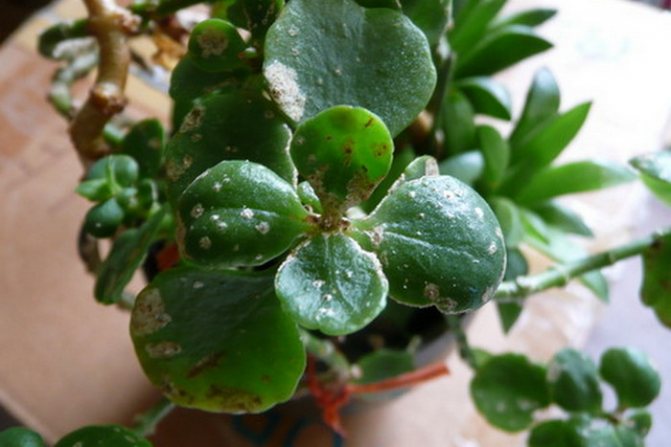

Misting of the plant is not allowed to prevent damage. In summer, the premises in which Kalanchoe are grown are well ventilated. On the windowsill, do not allow the leaves to come into contact with neighboring plants, especially those sprayed and often watered, such as Spathiphyllum or Aglaonema.
- Leaf spot
If numerous small (1-3 mm), first yellow spots appear on both sides of the leaves, eventually turn brown - leaf spot, a fungal disease caused by the fungus Stemphylium bolickii.
There are spots that do not increase in size for a long time. Sometimes the spots merge with each other, covering a significant part of the surface of the upper and lower sides of the sheet. Infected leaves gradually turn yellow and fall off. The fungus continues to develop on fallen leaves. In places of brown spots, spores develop, which are carried by drops of water (during watering) or insects to neighboring plants.
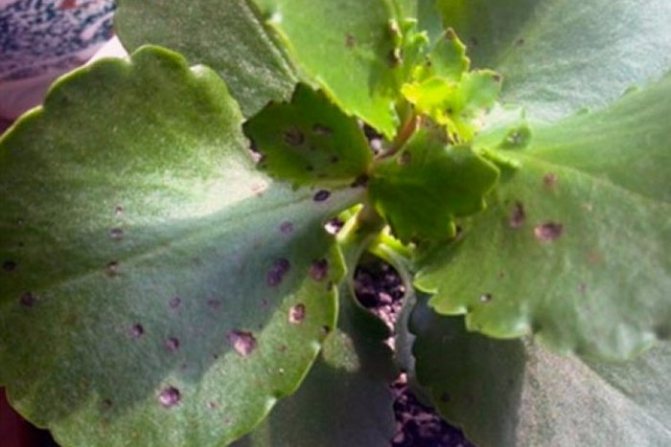

Moisture contributes to the development of leaf spot, so wetting the Kalanchoe during watering should be avoided. Water droplets left on the plant must be removed using a dry cloth. The flower pot is installed in a ventilated place. Fallen parts of the plant with signs of disease must be removed and destroyed. Spray the rest of the plant 1-2 times with biological products. In case of severe damage, spraying is done with stronger chemicals.
- Gray rot of Kalanchoe
Gray mold caused by Botrytis cinerea is one of the most common fungal diseases on plants. It affects all parts of the plant. Weakened or fertilized plants are especially susceptible to gray mold damage.
The most characteristic symptom is a dusty grayish coating of mycelium and spores that appears on the dying parts of the Kalanchoe. Before the appearance of plaque from the mycelium, watery brown spots form near the base of the shoots. Part of the shoot above the site of infection dies.
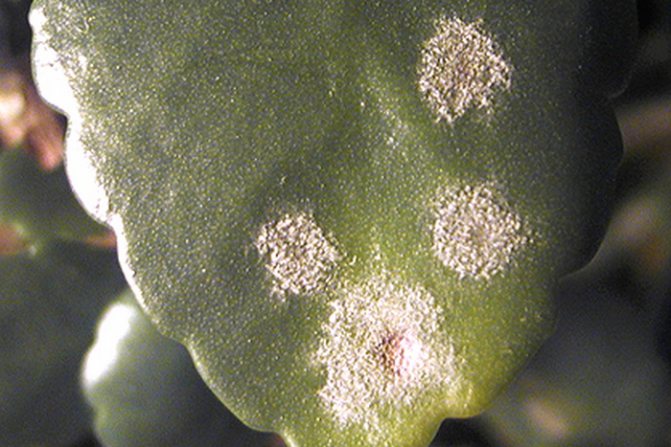

Gray mold develops where there is high humidity. Avoid wetting the flower when watering. Fallen parts of the plant should be regularly removed from the surface of the ground in a pot, especially if the ground is constantly wet. It is the plant residues that decompose in a humid environment that are the source of infection. Watering the Kalanchoe should be limited, especially in winter - up to once every 2 weeks. In winter, watering is recommended in the morning, so that during the day the parts of the plant soaked during watering can dry out. This is important as the fungus develops at night.
For the treatment of gray mold, Kalanchoe is sprayed twice (with an interval of 10 days) using the following preparations: Teldor 500 SC (0.25 ml / 250 ml water), Miedzian 50 WP (0.6 g / 250 ml water) or Biosept (0, 1 ml / 200 ml water).
Common diseases
Now let's talk in more detail about the diseases that are most often diagnosed in this culture.
Late blight is the disease that leads to ugly brown spots on the flower. If you literally tortured a flower with increased watering or if it clearly lacks ventilation, it is likely to get sick with late blight. When a flower begins to ache, dark spots dot almost every leaf. If nothing is done, the sheets will begin to bend up and fall off en masse. The plant needs to be rescued, for this buy the appropriate fungicide.
But besides the medicine, the flower also needs optimal care. To prevent diseases from pursuing the Kalanchoe in the future, start watering it correctly and, as necessary, apply fertilizer to the soil.
Powdery mildew is another common diagnosis. This is a common fungal disease that occurs due to excess moisture in the room. The disease provokes the shedding of foliage, followed by the death of the plant. Therefore, at the first suspicion of powdery mildew, begin to treat the flower.The disease is infectious, it will quickly move to other greens in the house, therefore the first measure is to isolate the diseased plant. The therapy consists in the use of fungicides.
There are several other Kalanchoe diseases that also need to be mentioned.
- Stem rot. You can trust the folk method, erase the stem plaque, and then disinfect this place with potassium permanganate (instead of potassium permanganate, some growers use ash). It is important to bring the temperature back to normal.
- Gray rot. She is also treated with fungicides. But even after their application, the plant needs resuscitation: it will require replacing the soil, ensuring the correct light regime.
When Kalanchoe disease is detected, examine other flowers in the room. It may be possible to find the source of the mass infection if it turns out that other flowers are also under threat.
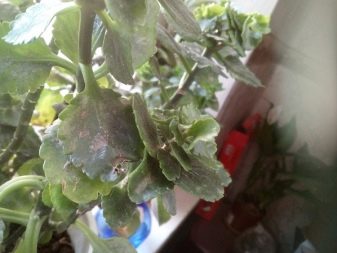

Why do the leaves and flowers of the blooming Kalanchoe dry
Many Kalanchoe species have a long flowering period. Its bushes are covered with bright small flowers, which cannot but cause joy and admiration. If you notice that the leaves of a flowering plant begin to dry and fall off, which is not a natural process during this period, then some violations have arisen that led to similar consequences.
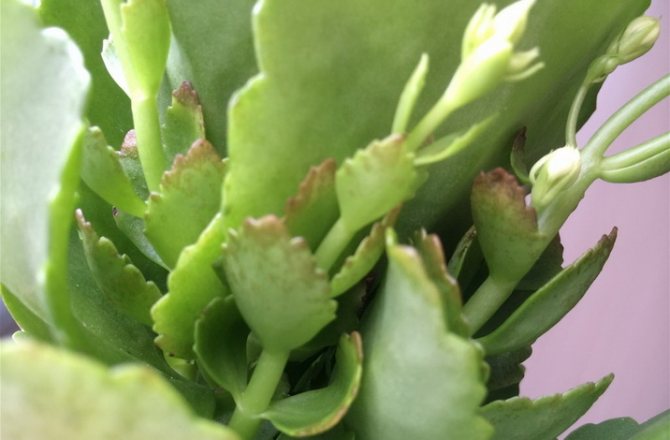

In the summer, the flower must be watered several times a week immediately after the earthen lump is completely dry. Do not overflow. Since it may seem that during the period of violent flowering, the plant does not have enough moisture, but this is completely wrong. Kalanchoe still has enough internal reserves in the leaves. You should adhere to the watering schedule 2 times a week.
If the watering was incorrect, excessive, then you should not reduce the amount of water application too sharply or stop it altogether, this is fraught with the fact that the flower may begin to shed its flowers and leaves ahead of time. It's best to avoid new stress and cut back on watering gradually.
Also, the leaves of the plant may begin to dry and fall off after a period of abundant flowering. In this case, the flower needs replacing the soil or feeding it. After flowering, the plant needs a radical pruning. The peduncle is removed, as well as all those pagons that look weak. It is better to cut the peduncle as low as possible to avoid rotting.
As mentioned above, the Kalanchoe is an unpretentious houseplant that needs a little moisture and lighting control. It is enough to take care of this flower for a few minutes once or twice a week, for which it will reward you with its beautiful magnificent appearance. As practice shows, the main reason for the problem of yellowing and drying leaves is improper watering, in particular, an excess of moisture (since it tolerates dryness better than waterlogging). And by adjusting the regularity of watering, you can avoid this problem. In addition, shedding leaves is not always a mistake in the care or disease of a plant, it can be a natural aging process of a flower.
How to save a flower?
Soap solution is the most popular folk remedy that is used in many cases. This kind of treatment can really help. Alcohol rubbing is also used: about three times a week, they rub the plant with a cotton swab dipped in vodka. You can replace alcohol with garlic infusion: five young cloves are ground, then diluted in a glass of water. Two hours of infusion in a dark place, filtering, and the infusion for spraying is ready. The scabbard can be removed from the sheet with a toothbrush.
In general, the scheme of what to do to treat a flower looks like this:
- he should arrange for proper care;
- if pests attack the flower, they must be eliminated in any suitable way, without wasting time;
- pinch;
- observe the optimal indicators of humidity, light mode and temperature;
- feed the plant.
These manipulations help the Kalanchoe to recover.On average, feeding is carried out once a month. Very often fertilizer for succulents is used for this purpose, but it is permissible to use complex additives (they give a good, lush flowering). Fertilizer should be applied as carefully as possible. If you overdo it with feeding, then the plant will not bear the abundant growth of the green mass, and it will not reach the flowers at all.
Pinching a flower helps not only to heal it, but also prevents it from drying out. You can pinch off with anything, the main thing is that the tool is processed, and the procedure is carried out carefully, without haste. If you can't pinch off carefully, sprinkle the wound with ash or charcoal.
It will not be possible to get rid of diseases without emergency measures, but even if you have cured Kalanchoe, special attention will have to be paid to its rehabilitation. It consists in maintaining an optimal complex of care.
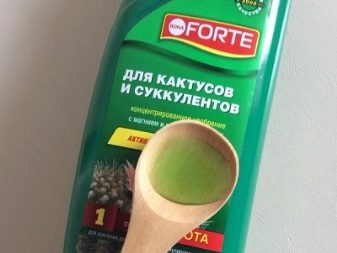

Leaf diseases
Yellowing of leaves
Why does Kalanchoe turn yellow and what to do with it? This usually happens after flowering. The stem is pulled out and exposed from below.
This is a sign of exhaustion. We need new soil and intensive feeding.
Transplant the plant into a new substrate. After transplanting, feed him with Zircon solution.
Why Kalanchoe often leaves turn yellow and dry from the tips? This is primarily due to a lack of boron and you need to feed the flower with fertilizer with a high content of this substance.
Rolling the leaves
Why do Kalanchoe leaves curl? In Kalanchoe, leaves curl most likely due to damage to the root system.
The reason for this is excess water. Remove the plant from the pot and examine the roots.
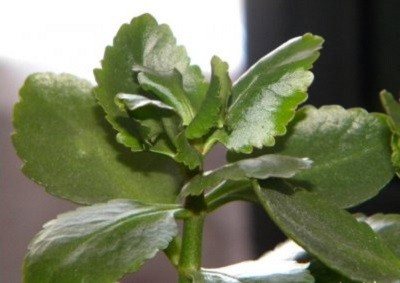

Damage must be cut out, the healthy part must be washed in a weak solution of potassium permanganate.
Then treat the cuts with charcoal powder and plant the remaining portion in fresh soil.
Why do Kalanchoe leaves curl?
If a the leaves are curled and at the same time they change color to burgundy, which means that the plant is in an overly lit place, direct rays fall on it for a long time during the day.
In this case, shade the flower and spray it during the day.
Leaves fall
Why does Kalanchoe shed its leaves? Have Kalanchoe fall leaves due wrong content in winter. This happens when the flower is kept in a stuffy room, next to heating radiators.
If you notice this, move it to a colder room. It is desirable that the temperature in it be no higher than 15 degrees. In this case, the winter will pass without losses.
So why leaves fall the Kalanchoe and what to do? Another reason for this may be the coolness, which is not combined with moisture - appears on the leaves mold or black spots... It's a fungus. Fungicides will help to destroy it.
Why is the Kalanchoe withering?
What to do, if Kalanchoe withers? Why does the plant have soft leaves? The reason depends on the age of the plant.
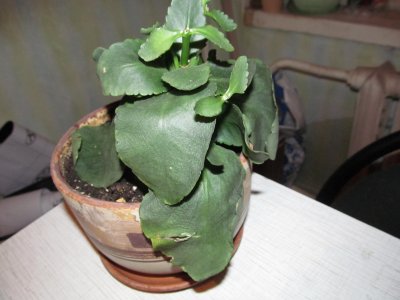

If it is young, then such signs indicate a lack of water. But this is not necessarily related to quantity.
If the root has rotted, then moisture does not enter the leaves, but accumulates in the soil.
This can be the case with irregular watering.
If the ground dries out too much, and then watered abundantly, then the plant can also wilt.
Watering should be done when it dries, not when it dries out.
In an adult Kalanchoe, leaves wither due to aging. Rejuvenate him. Separate the cuttings and replant.
Black spots on the leaves
If the leaves of Kalanchoe turn black, this signals the presence of a fungus. This comes from an excess of moisture, the soil does not dry out and its aeration is impaired.
Change the soil, increase its looseness by adding sand. Adjust the watering in the future and then the leaves of the Kalanchoe will not turn black.
Brown spots on the leaves
Dry brown crusts on the leaves is Kalanchoe diseasecalled dropsy... It arises from temperature changes combined with waterlogging.
Move the Kalanchoe to a warmer and drier place, reduce the amount of water in the watering. Make sure that cold air does not get on it, for example, when ventilating.
White bloom on the leaves
Kalanchoe covered white bloom due to the fact that the water for irrigation too tough... It contains salts and lime impurities.
It needs to be softened: defended, filtered. A good remedy is freezing and subsequent thawing.
To soften once a month, you can add citric acid to it at the tip of a knife per liter. You can add 3% vinegar - 1 teaspoon per liter. The liquid with the acid is defended for two days so that all the salts settle, then they are drained and used for irrigation.
The leaves have dropped
Mainly Kalanchoe drops leaves because of the plant is cold... This often happens when overflowing in a cold room. Move the Kalanchoe to a warm, dry place.
If it doesn't recover, change the soil. At the same time, plant the plant in almost dry soil and water it only after 1-2 days, when the excess moisture is gone.
Kalanchoe grows upward and does not bloom
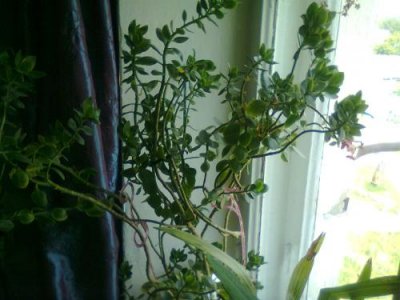

A feature of the Kalanchoe is abundant flowering in the first year of life. So why then does the flower grow up and not bloom? After the initial flowering, it enters a dormant phase.
Read also: Growing roses from cuttings from a bouquet
Starts stretch up and does not bloomaccumulating leaves. To make it take on new buds, you need to form a bush.
Cut off the tops and root them. You will receive new plants, and old specimens will begin to accumulate strength for budding.
What to do, if Kalanchoe stretched out? Remove a couple of top leaves from such shoots. After that, new shoots will grow on them.
Do this until your flower becomes a lush, rounded bush.
To stimulate flowering, they also undertake a reduction in daylight hours to 12 hours. Remove the Kalanchoe in a dark place at 7 pm, and put it back into the light at 7 am.
Why do Kalanchoe have small leaves?
Leaves become shallow and dull due to lack of light.Kalanchoe needs a bright light as long as possible during the day.
We do not recommend keeping it away from the window or on the north windows. Also, the size is affected by the sufficiency of nutrients, so the plant needs to be fed regularly.
This is especially necessary during the period of budding and flowering, since at this time he needs a lot of strength. Feed every 14 days.
Gnawed leaves
Why do Kalanchoe have gnawed leaves? Sometimes holes appear on the leaves, as if someone had chewed out pieces. These are burns that occur when spraying in direct sunlight.
The drops act as lenses and the sun burns through the delicate skin. These areas turn into small holes.
Leaf diseases and pests of Kalanchoe:

